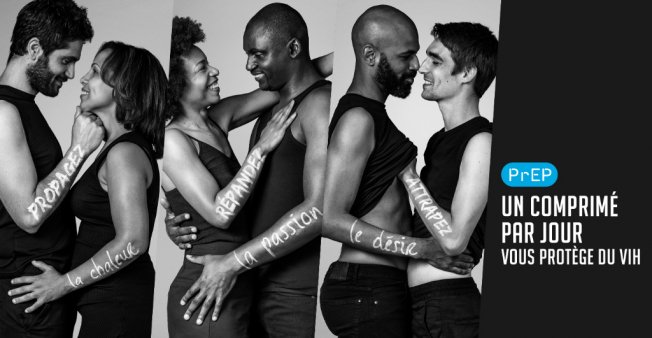
“PrEP: A pill a day protects you from HIV”, states the campaign, which was launched in major cities across France on July 4th. The slogan is accompanied by a black-and-white image of couples, both gay and straight, advocating use of the pill.
Designed for people who do not have HIV but are at substantial risk of infection, PrEP has been available in the United States since 2012, and the United Kingdom since 2017. But it remains little known in France.
“There isn’t enough awareness of the treatment. That’s why we’re doing this campaign, because the public authorities haven’t. As a consequence, its use has been limited to the gay community,” Antoine Henry, a spokesman for the national AIDS Association, told FRANCE 24.
Targeting high risk populations
PrEP (which is a contraction of the pill’s name: Pre-Exposure Prophylaxis) has been on the market in France for 18 months. But only 7,000 people have used the brand-name, Truvada, or other generic forms of the drug, which are manufactured by three main pharmaceutical labs: Sandoz (in Switzerland), Teva (in France), and Gilead (in the United States).
“It’s a prevention tool for people without HIV, but who belong to segments of the population that are at high risk of being exposed to the virus: men who have sex with other men, gays, bisexuals, or bi-curious heterosexuals and migrants, in particular from sub-Saharan Africa, where there’s an epidemic in some countries,” Henry said.
The cost of the pill, which is only available with a prescription, is entirely covered by France’s social security system. The AIDS Association advocated it as an excellent alternative for people who struggle to use condoms: “It’s in their best interest to use PrEP, because beyond guaranteeing that they won’t be infected, it also ensures that they’ll have closer care.”
Small risk of infection
PrEP has proven highly effective abroad. In San Francisco, the number of new HIV infections plummeted by 49 percent between 2012 and 2016. In the UK, the infection rate dropped by 18 percent between 2015 and 2016, according to a recent report by Public Health England, which partly attributed the fall to the “increasing availability of PrEP”, both online and through medical trials.
If used the right way, PrEP can be as effective as wearing a condom. It has been shown to reduce the risk of HIV infection by up to 92 percent when taken consistently, according to the Centers for Disease Control and Prevention (CDC) in the US.
“It’s the same idea as the contraceptive pill. If it’s taken every day, even after exposure to the virus during unprotected sex, you’re sure not to be infected,” Henry said. “But you need a medical prescription, care and regular testing.”
Yet some public health experts worry that the antiviral drug could encourage unprotected sex, leading to a rise in other sexually transmitted diseases (STDs). A recent study in Australia found that an increase in PrEP use among gay and bi-sexual men in Melbourne and Sydney was linked to a decrease in consistent condom use.
“This idea that advocating tools other than condoms could trivialise the epidemic is understandable, but factually inaccurate,” Henry said. “The reality is that the people who take PrEP already have a problem with using condoms during relations.”
The AIDS Association is careful to stress that although PrEP protects against HIV, it is not effective against other STDS. Only condoms can protect against STDs spread through bodily fluids, such as gonorrhea, syphilis, hepatitis and chlamydia, and unwanted pregnancies. The drug is also not advised for people who have tested HIV-positive.
There are an estimated 37 million people across the globe living with HIV or AIDS, according to the World Health Organization. The disease has killed 35 million of the 80 million people infected since it was first detected during the 1980s. Despite increased awareness, there are still well over a million new cases in the world each year.
